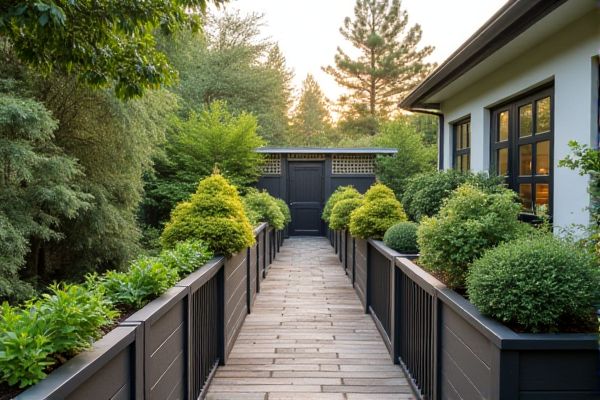
A double rail planter offers enhanced seed spacing accuracy and increased planting speed compared to a single rail planter, making it ideal for larger fields and more complex planting patterns. Discover how choosing the right planter can optimize Your crop yield and efficiency as you read the rest of this article.
Table of Comparison
| Feature | Double Rail Planter | Single Rail Planter |
|---|---|---|
| Structure | Two parallel rails for planting alignment | Single rail used for planting guidance |
| Precision | Higher precision in seed placement | Moderate precision |
| Planting Speed | Slower due to complexity | Faster operation |
| Cost | Higher initial investment and maintenance | Lower cost and simpler maintenance |
| Application | Best for crops requiring exact spacing (e.g., vegetables) | Suitable for general planting needs |
| Durability | More robust due to dual rails | Less robust, easier to wear |
Introduction to Rail Planter Systems
Rail planter systems enhance planting precision by guiding seed placement along predefined tracks, improving crop uniformity and reducing overlap. Double rail planters utilize two parallel rails to provide superior stability and consistent seed spacing compared to single rail planters, which rely on a single guiding mechanism. The dual-rail configuration improves operational efficiency on uneven terrain, minimizing seed skips and maximizing field coverage.
Key Differences: Double Rail vs. Single Rail Planters
Double rail planters offer enhanced stability and wider coverage compared to single rail planters, making them ideal for larger gardening areas or commercial use. Single rail planters are typically more compact and easier to move, suitable for smaller spaces or personal gardens. Understanding these key differences helps you choose the right planter based on your space, durability needs, and planting goals.
Design and Structural Features
Double rail planters feature two parallel support rails that enhance structural stability and allow for evenly distributed weight, reducing the risk of planter sagging over time. Single rail planters rely on one central support rail, which simplifies design but may limit load capacity and increase stress on mounting points. The dual-rail configuration often includes reinforced brackets and crossbars, providing superior durability and resistance to bending compared to single rail systems.
Space Utilization and Layout Efficiency
Double rail planters maximize space utilization by allowing two rows of plants to be grown simultaneously on parallel tracks, effectively doubling planting capacity within the same area compared to single rail planters. The increased layout efficiency reduces wasted space and optimizes pathways for easier maintenance and harvesting. Your growing area benefits from enhanced productivity and streamlined movement, making double rail systems ideal for maximizing limited greenhouse or garden space.
Plant Support and Stability
Double rail planters provide enhanced plant support and stability by offering two parallel rails that secure stems and branches more effectively than single rail planters. Your plants benefit from increased structural reinforcement, reducing the risk of bending or breaking under weight or wind pressure. This design is particularly advantageous for taller or heavier plants, ensuring better growth and durability.
Installation Process and Requirements
Double rail planters require more precise ground leveling and additional anchoring points during installation compared to single rail planters, which simplifies setup with fewer supports. The double rail system demands careful alignment to ensure even spacing between rails, increasing installation time and labor costs. Single rail planters offer faster installation due to their straightforward design, making them suitable for smaller-scale projects with limited infrastructure requirements.
Maintenance and Durability Comparison
Double rail planters offer enhanced durability due to their reinforced frame and balanced load distribution, reducing wear and tear during operation. Maintenance requirements for double rail planters are generally lower since the even weight distribution minimizes stress on individual components, extending their lifespan. Your choice will benefit from fewer repairs and less downtime compared to single rail planters, which often experience higher maintenance needs due to uneven stress and potential frame bending.
Cost Analysis: Upfront and Long-Term
Double rail planters typically have a higher upfront cost due to increased material and manufacturing complexity but can offer greater planting efficiency and reduced input waste. Single rail planters are more cost-effective initially and require less maintenance, though they might incur higher long-term expenses from slower planting speeds and less precise seed placement. Evaluating Your budget against operational needs helps determine whether the long-term savings with double rail systems justify their initial investment.
Best Applications for Double and Single Rail Planters
Double rail planters excel in large-scale row crop planting, offering enhanced seed spacing accuracy and stability on uneven terrain, making them ideal for corn and soybean fields. Single rail planters provide versatility and agility, suitable for smaller farms or diverse crop types like vegetables and specialty grains where maneuverability and adaptable spacing are critical. Choosing between double and single rail planters depends on field size, crop requirements, and soil conditions to optimize planting efficiency and yield potential.
Choosing the Right Rail Planter for Your Needs
Double rail planters offer enhanced stability and load distribution, making them ideal for heavier plants and larger garden designs, while single rail planters are more space-efficient and lighter, perfect for small balconies or indoor settings. Selecting the right planter depends on factors such as plant size, weight capacity, available space, and aesthetic preferences. Prioritize durability and ease of installation to ensure the planter supports your gardening goals effectively.
 homyna.com
homyna.com